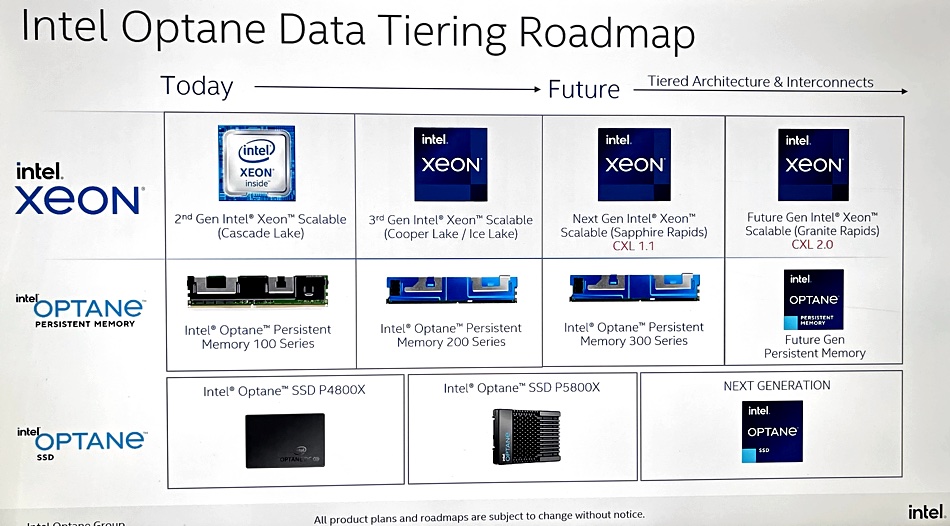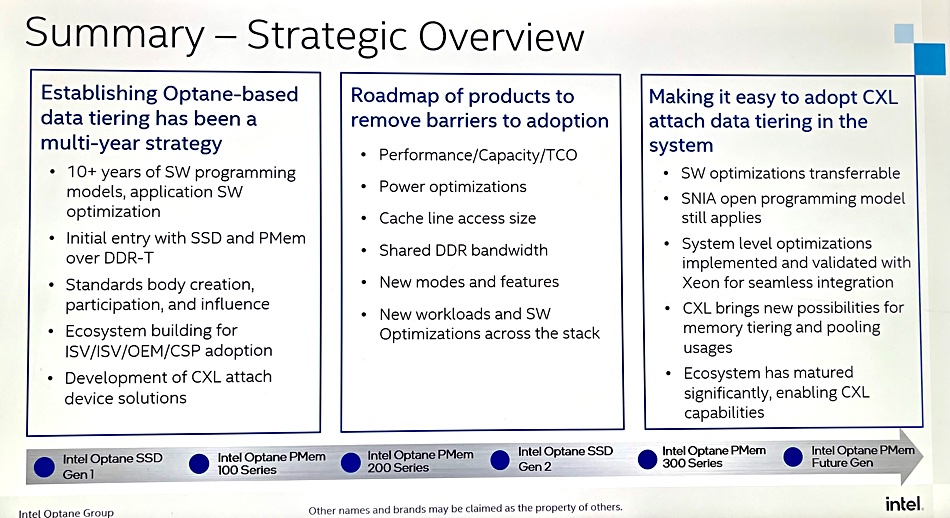Intel will use existing gen 2 3D XPoint media in its third generation Optane SSDs and Persistent Memory products, and gen 4 Optane devices will likely be freed from Xeon dependency.
These points were revealed by Kristie Mann, VP and GM at Intel’s Datacenter and AI (DCAI) group, and other presenters at a Tech Field Day Session on April 8. Optane is Intel’s storage-class memory using 3D XPoint media – it is faster than NAND but slower than DRAM.
Gen 1 Optane SSDs and Persistent Memory DIMMs were introduced in 2018 with gen 2 devices (P5800X SSD and PMem 200 Series DIMMs) coming in 2020. These used gen 2 3D XPoint media with four layers of cells rather than gen 1’s two.
Mann showed an Optane roadmap slide and said: “Coming near the end of this year, we’re going to have our 300 series.”

The roadmap links Optane Persistent Memory (PMem) and Xeon CPU generations, with the current PMem 200 series synced with Cooper Lake and Ice Lake gen 3 Xeon processors.
The future Optane PMem 300 series will be twinned with Sapphire Rapids Xeons, Intel’s fourth generation of its scalable processor design. Sapphire Rapids will support CXL v1.1, an interim CXL specification before CXL 2.0, which will introduce memory pooling, which is the ability to have pools of memory remotely accessed over the CXL bus.
Mann confirmed the PMem 300 series will use PMem 200 Series Optane media: “It’s using second generation Optane media.”
That means Intel, as yet, has no public plans to develop 3rd-generation 3D XPoint media with, for example, 8 decks or layers compared to the second XPoint media generation and its 4 decks.
CXL 2.0
Some of an Optane device’s controller functions are carried out by a Xeon host CPU.
Mann said: “With Optane, we actually put part of the memory controller in the Xeon processor. So we we’ve come out with all sorts of memory control optimizations right in the Xeon processor itself.”
That means Optane can only be used in servers with Xeon CPUs.
The coming third generation Optane SSD, Lake Stream in Intel’s code-name, will be developed and arrive in the Sapphire Rapids era and overlap with Grand Rapids. The Optane SSDs are not closely tied to Xeon generations whereas the Optane PMem have been synchronised with Xeon CPU families. Mann said this could end: “Once we’re a fully compliant CXL persistent memory type of device, we may also have the flexibility to decouple from Xeon.”
The Granite Rapids iteration of the Xeon processor will support CXL 2.0, at least that’s Intel’s intention, and a future Optane PMem product – logically the PMem 400 Series – will support CXL 2.0 as well. Mann said: “And at that point, that’s when we want to have a CXL type of device for persistent memory. In that timeframe.”
In more detail she said: “So let’s put it this way: this CXL standard is still in development. So I would say we have very limited visibility into what types of devices and functionality are being built into all of the various … processors and controllers out there.
“Our approach right now, just like it has been with starting with a minimum viable product in the first generation and moving forward, is that we’re we’re doing all of the design, the validation, the optimization around Xeon. And we’re not actively going out and trying to connect to other types of processors, but it is going to be a CXL-compliant device. And so depending on how everybody implements these things, there could be compatibility. Just we’re not designing for, or guaranteeing it at this point in time,” Mann said.
Three other points. First, Intel is going to make it possible to address smaller portions of Optane memory. Intel Fellow and Senior Software Engineer Andy Rudoff said: “The things you see listed here, like optimising the power utilisation generation over generation, or making finer granularity access to our media, that’s the cache line access size.”

Secondly, CXL 2.0 should see performance increases: “Optane and CXL, I gotta say, are like made for each other … So the RAM has the DDR bus all to itself. Octane has CXL and now we get concurrency, those two things operating at the same time that we didn’t have before. So we should see some great improved performance by splitting that apart.”
Lastly, when Optane is available on CXL 2.0, the existing Optane applications should still work, said Intel.







